|
Jewel of the 33rd
Degree
Sovereign Grand
Inspector-General
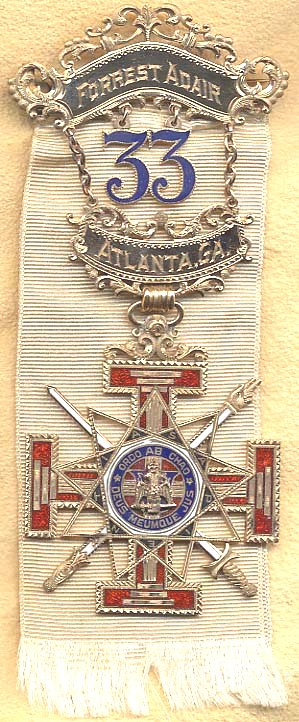
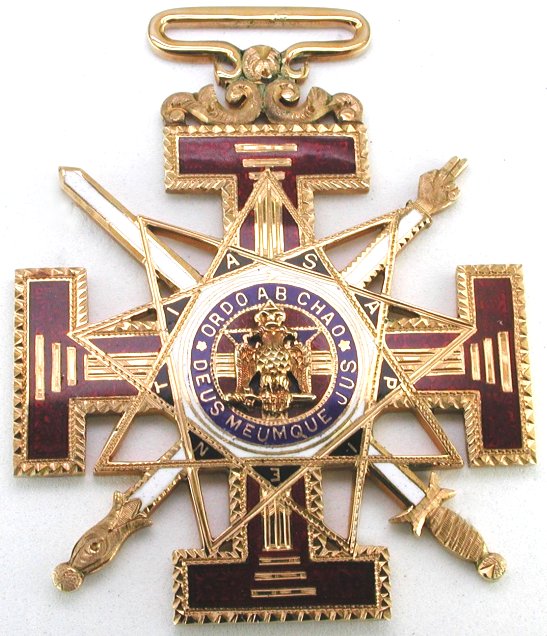
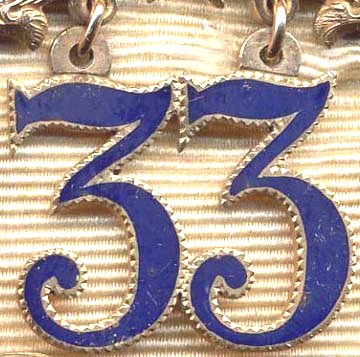
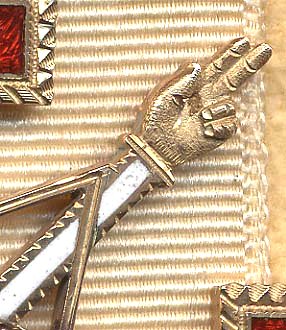
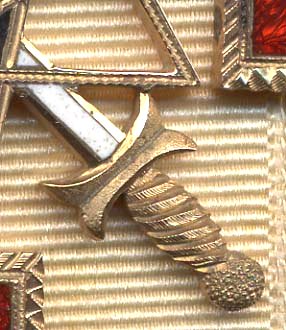
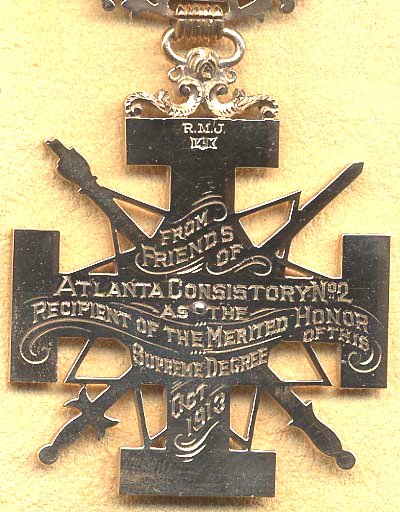
This beautiful jewel represents the Thirty-third
and Last Degree of the Ancient and Accepted Scottish Rite. It belonged to
Illustrious Brother Forrest Adair from Atlanta Consistory No. 2.
(See Brother Adair's Masonic History below) It was
presented to him in October of 1913.
The Latin Constitutions
of 1786 call it Tertius et trigesimus et sublimissimus gradus, that is, the
Thirty-third and Most Sublime Degree; and it is styled the Protector and
Conservator of the Order. The same Constitutions, in Articles I and II, say:
"The Thirty-third Degree confers on those
Freemasons who are legitimately invested with it, the quality, title, privilege, and
authority of Sovereign, Supremorum, Grand Inspectors-General of the Order. The
peculiar duty of their mission is to teach and enlighten the Brethren; to preserve
charity, union, and fraternal love among them; to maintain regularity in the works of each
Degree, and to take care that it is preserved by others; to cause the dogmas, doctrines,
institutes, constitutions, statutes, and regulations of the Order to be reverently
regarded, and to preserve and defend them on every occasion; and, finally, everywhere to
occupy themselves in works of peace and mercy."
The Body in which the members of this Degree
assemble is called a Supreme Council. The symbolic color of the Degree is
white, denoting purity. The distinctive insignia are a sash, collar, jewel, Teutonic
cross, decoration, and ring.
The sash is a broad, white watered ribbon,
bordered with gold, which has in the center the numerals 33, with a sword of silver,
directed from above, on each side of the triangle, pointing to its center. The sash,
worn from the right shoulder to the left hip, ends in a point, and is fringed with gold,
having at the junction a circular band of scarlet and green containing the jewel of the
Order.
The collar is of white watered ribbon fringed
with gold, having the rayed triangle at its point and the swords at its sides. By a
regulation of the Southern Supreme Council of the United States, the collar has been worn
by the active, and the sash by the honorary, members of the Council.
Emblem of the Thirty-Third
Degree
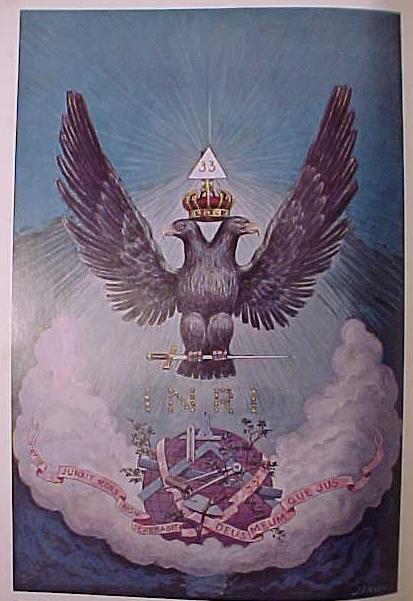
The emblem is a black double-headed eagle, with
golden beaks and talons, holding in the latter a sword of gold, and crowned with the
golden crown of Prussia. The red Teutonic cross is affixed to the left side of the
breast.
The decoration rests upon a Teutonic cross.
It is a nine-pointed star, namely, one formed by three triangles of gold one upon
the other, and interlaced from the lower part of the left side to the upper part of the
right a sword extends, and in the opposite direction is a hand of, as it is called, Justice.
In the center is the shield of the Order, azure (blue), charged with an
eagle like that on the banner, having on the dexter (right) side a Balance or (gold), and
on the sinister (left) side a Compass of the second, united with a Square of the second.
Around the whole shield runs a band of the first, with the Latin inscription, of
the second, Ordo ab Chao, meaning Order out of Disorder, which band is
enclosed by two circles, formed by two Serpents of the second, each biting its own tail.
Of the smaller triangles that are formed by the intersection of the greater ones,
those nine that are nearest the band are of crimson color, and each of them has one of the
letters that compose the word S.A.P.I.E.N.T.I.A., or Wisdom.
The ring is a triple one, like three small
rings, each one-eighth of an inch wide, side by side, and having on the inside a delta
surrounding the figures 33, and inscribed with the wearer's name, the letters S.G.I.G.,
and the motto of the Order, Dues meumque Jus, meaning God and my right.
It has been worn on the fourth finger of the right hand but in 1923 provision
was made that the Thirty-third Degree ring should be worn on the little finger of the left
hand in the Southern Jurisdiction. The ring is worn on the third finger of the left
hand in the Northern Jurisdiction of the United States of America.
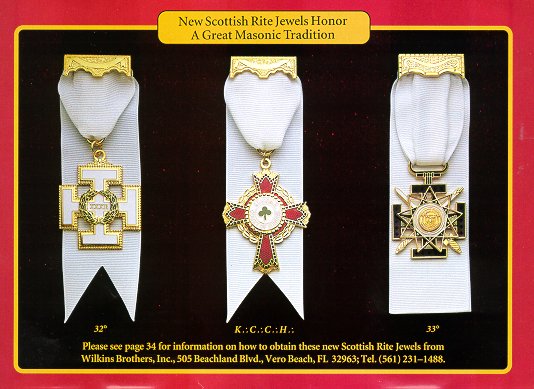
Here are the
new Scottish Rite Jewels available to members!
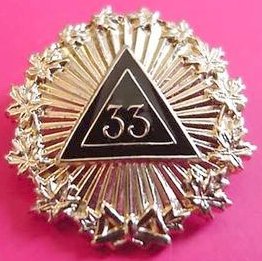
33rd Degree Scottish Rite Lapel
Pin

Illustrious Brother
Forrest Adair from Atlanta Consistory No. 2 and Yaarab Shrine Temple
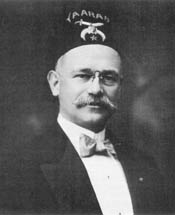
The "Bubbles" Speech
The song, “I’m
Forever Blowing Bubbles,” has held special meaning to Shriners since the
46th annual Imperial Council
session in June 1920, in Portland, Oregon; for it was, at that meeting, that the
assembled Shriners voted on the resolution to establish the
Shriners’ Hospital for Crippled Children [now known as the
Shriners Hospitals for Children in recognition of our expansion into
paediatric burns care], to be initiated with a two-dollar tithing imposed upon
each Shriner.[1]
|
The resolution to
establish the Hospitals was introduced by outgoing Imperial
Potentate W. Freeland Kendrick (Lu
Lu Shriners, Philadelphia [now in Plymouth Meeting]), in the shadows of
a defeated proposal the previous year to establish an orphans’ home,
introduced by Noble Philip D. Gordon (Karnak
Shriners, Montréal).[2]
, and seemed to turn the tide against the
plan,[4]
but Noble Forrest Adair (Yaarab
Shrine, Atlanta) rose from his seat near the front of the audience and
put an end to the nobles’ reluctance with his now-famous “Bubbles” speech.
Five years earlier,
Noble Adair, as Commander in Chief of the
Scottish Rite’s Atlanta Consistory, had been the virtual founder of the
Scottish Rite Hospital for Crippled Children in Atlanta[5]
[which has since merged with Egleston Children’s Hospital to become
Children’s
Healthcare of Atlanta at Scottish Rite].[6]
Noble Adair spoke thus:
I rise, unlike my friend, Past Imperial Potentate Melish,
without reluctance, but with enthusiasm.
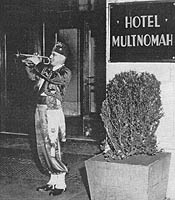
I was lying in bed yesterday morning, about four
o’clock in the Multnomah Hotel, and some poor fellow who had strayed away
from the rest of the band – and he was a magnificent performer on a baritone
horn – stood down there under the window for twenty-five minutes playing “I
am only blowing bubbles.” [sic] (Laughter.) Do you catch it?
(Laughter.) And after a while, when I dropped back into a peaceful sleep, I
dreamed of a little crippled children’s hospital, run by the Scottish Rite
Fraternity, in Atlanta, Georgia, which has been visited by a number of the
members of this Imperial Council, and I though of the wandering minstrel of
the early morning, and I wondered if there were not a deep significance in
the tune that he was playing for Shriners, “I am only blowing bubbles.” [sic]
We meet
from year to year; we talk about our great Order; we read the report on the
hundreds of thousands of dollars that are accumulated and loaned to banks
and paid us for our mileage and per diem, and on our visitations we stop in
some oasis and we are taken in an automobile by a local committee, and he
first drives us by and shows us, “This is our temple, our mosque. It is
built of marble brought from Maine or Georgia. The lot cost fifty thousand
dollars; we could have sold it for two hundred thousand dollars before we
built upon it. the building cost us a million, and it could not be put up
now for two and a half million.”
“What is
that wonderful hospital over there?” I ask.
“That is
the hospital of the Sisters of Saint Mary.”
“What big
school is that in the distance?”
“That is
a school erected and maintained by the Catholic Church.”
And we
get here and we hear the baritone. That fellow told us what we were doing.
The last
United States census on this point shows us that there are four hundred
thousand cripples in Georgia – (laughter) – there are four thousand in
Georgia; there are four hundred thousand in the United States of America.
And unfortunately, they are in the almshouses; they are in the homes; they
are mendicants; they are paupers; and the best alms that you can give is
that which will render alms unnecessary.
My
Brother Melish goes back to these other resolutions which have been
postponed from year to year, while we may blow more bubbles and sing again,
‘Hail, hail, the gang’s all here.’ This resolution has been changed. It does
not establish, Brother Melish, a home. The word there is ‘hospital’; 'The
Shriners Hospital for Crippled Children’ I presume that any intelligent
committee that may be appointed by the incoming Imperial Potentate will
provide rules that, in the first place, no child be admitted – it is our
rule down there [at the Scottish Rite Hospital – ed.] – unless, in the
opinion of the surgeons after careful examination, its trouble can be
corrected or benefited. We take no feeble-minded. We do take them [children,
not feeble-minded – ed.] from adjoining states. I have never had, and we
started out without a dollar down there to build it, except about eight
thousand dollars; I have been on the board from the beginning, and I have
never had any very bad time getting all the money it wants, as long as G-d
Almighty continues to put an occasional drop of the milk of human kindness
in our blood.
I would
give one thousand dollars in cash now if I had brought with me our Annual,
which was printed just a few weeks ago; and I did send a few of you copies
of it. I would show you a picture of a fifteen-year-old girl that had walked
like a quadruped on her hands and knees, and under the magic skill of one of
the greatest orthopedic surgeons that has ever lived, – and who gives us his
time without pay, – who when I was out at the hospital three months ago
greeted me by saying, “Come here, Mr. Adair. I stand for the first time in
my life erect.” And that child’s condition is worth two million dollars, –
every bit of it.
My
Brother Melish says that it places upon us responsibility. No, no, it does
not. This resolution merely recognizes the fact that we appreciate that the
responsibility is upon us, and while we have spent money for songs, and
spent money for bands, – and they mean so much to us let us keep it up, –
you cannot put your finger on a thing that I know of that has been done for
humanity that can be credited to the Shrine as an organization. If this is
established, these little rules and regulations that Brother Melish is so
afraid of will be taken care of by a competent committee. If they don’t do
it right and devote themselves too much to the Catholic children, the Negro
children, we can fire them and get another committee. I apprehend we will
not want to restrict it to the crippled children of Shriners. We don’t. The
first prerequisite with us is that the child’s trouble may be corrected or
improved. The second prerequisite is that they shall be financially unable
to pay. You could not get your child in that hospital if you would pay a
thousand dollars a week, because you would be depriving some little pauper
child of a bed.
I want to
see this thing started. For G-d’s sake, let us lay aside the soap and water
and stop blowing bubbles and get down to brass tacks. If there is anything
in the resolution that has formerly been passed that precludes it, let’s
reconsider it and do away with the other one. Let’s blow all the dust aside.
Let’s get rid of all the technical objections. And if there is a Shriner in
North America, after he sees your first crippled child has been treated, in
its condition, objects to having paid the two dollars, I will give him a
cheque back for it myself.
I
earnestly hope that this resolution may pass. I hope that within two or
three, four or five years from now, we will be impelled, from the wonderful
work that has been done, to establish more of these hospitals, in easy reach
of all parts of North America. Every argument that Brother Melish makes,
every argument that Brother Melish has presented against this is, to my
mind, an argument in favour of it.
The room erupted with applause, and it was clear that
Noble Adiar’s monologue had touched the hearts of those assembled. Fellow
Yaarab Noble, Robert Colding stood and echoed Noble Adair’s sentiments, as
did the following men: Noble Opie (Ararat
Shrine, Kansas City), Noble Charles E. Ovenshire (Zuhrah
Shrine, Minneapolis), Noble Edward C. Day (Algeria
Shriners, Helena, Montana), Noble Henry Lambsburgh (Almas
Shriners, Washington, D.C.), Noble F. F. Whitcomb (Tangier
Shrine, Omaha), and Noble J. Harry Lewis (Osman
Shriners, Saint Paul).
Imperial Sir Kendrick attempted to give the final
statement in favour of his resolution: “The time has come, when we should do
something big. And what can you do as big as to furnish a hospital for a
poor little crippled child? Suppose it is Black; suppose it is Catholic; G-d
put it here on earth and it is up to us to help it. And it means Canada as
well as the United States, for our jurisdiction is North America.”
Kendrick’s intent to have the final word was foiled
when Melish stood again; but any fears that Kendrick, Adair, or the other
champions of the Hospital may have had were quickly dashed when Melish
asserted, “I want to say just one word. I think I know how this thing is
going. I think the duty of us all, the duty of myself first, is that if
action is to be taken today, as it is, upon this matter, that we want to go
before the world showing that the vote was unanimous, and that is the way I
am going to vote.” Indeed, the resolution passed with unanimous consent.
Noble Adair was appointed a member of the committee to
establish what became the Shriners Hospitals for Children, by incoming
Imperial Potentate Ellis Lewis Garretson (Afifi
Shriners, Tacoma). Noble Adair was joined by Noble Sam P. Cochran (Hella
Shrine, Dallas [now Garland]), Imperial Sir Kendrick, the aforementioned
Noble Phillip D. Gordon, Noble Oscar M. Landstrum (Algeria Shriners), Noble
John D. McGilvray (Islam [n/k/a
Asiya]
Shriners, San Francisco [now San Mateo]), and Noble John A. Morison (Kismet
Shriners, Brooklyn [now New Hide Park]).
Who was the “wandering minstrel” who incessantly
played I’m Forever Blowing Bubbles on his baritone horn outside of
the Multnoma Hotel in the early morning of 21 June 1920, unknowingly
inspiring the founding of
Shriners Hospitals for Children? At least four Shrine temples have
asserted that he was one of their brethren.Imperial Sir Kendrick penned in
the Shrine News an article “Echoes of the Past,” in which he
suggested the man may have been Noble Eugene Reitz (Isis
Shrine, Salinas, Kansas). |
––––––––––––––––––––––––––––––––
1.
Past Imperial Potentate William B. Melish, The History of the Imperial
Council, Ancient Arabic Order, Nobles of the Mystic Shrine For North America,
2nd ed., 1872-1921 (Cincinnati: The Abingdon Press, 1921), 237-238.
2.
Fred van Deventer, Parade to Glory: The Story of the Shriners and Their
Hospitals for Crippled Children (New York: William Morrow and Company,
1959), 180-182.
3.
Ibid., 97-100, 109
4.
Ibid., 186.
5.
J. Ed. Hart, “...Unto the Least of These”: A Story of the Shriners’ Hospitals
for Crippled Children (Greenville, South Carolina: The Board of Governors
and the Staff of the Greenville, South Carolina Unit, Shiners’ Hospitals for
Crippled Children, 1948), 20. See also W. O. Saunders, “Let’s Stop
Blowing Bubbles,” Collier’s Weekly, 13 Sept. 1924; reprinted at
The Builder, vol. X, No. 10.
See Noble Adair’s 33° jewel by clicking here.
6.
Orient of Georgia, Ancient & Accepted Scottish Rite of Freemasonry, “The Georgia
Scottish Rite Charities”
http://gascottishrite.org/Charities/charities.html
7.
Noble Forrest Adair (Yaarab Shriners, Atlanta, Georgia), “The Bubbles Speech”
(argument presented at the annual meeting of the Imperial Council of the Ancient
Arabic Order, Nobles of the Mystic Shrine, in Portland, Oregon on 22 June 1920),
reprinted in Hart, supra, 20-24.
8.
van Deventer, supra, 190.
9.
Ibid.
10. Ibid.
11. Ibid.
12. Noble John D. McGilvray, The Shriners Finest Hour (San Francisco,
California: Board of Governors, Shriners Hospital for Crippled Children, 1955),
5. [ed. note: the former San Francisco Unit of the Shriners Hospital is now the
Sacramento Unit.]
13. van Deventer, supra, 190.
14. W. Freeland Kendrick, “Echoes of the Past,” Shrine News,
[publishing information unknown, presumably in the early 1940s], see
Hart, supra, 25-27.
15. Hart, supra, 19.
*
The portrait of Noble Forrest Adair appeared in
van Deventer, supra, 187.
**
The staged photograph, re-enacting the performance of
the “wandering minstrel” appeared in Hart, supra, 26.
I'm Forever Blowing Bubbles
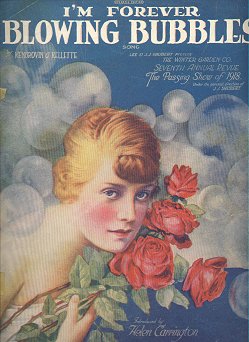
© 1919 by
Jaan Kenbrovin
& John William Kellette
I’m dreaming dreams,
I’m scheming schemes, I’m building
castles high.
They’re born anew, their days are
few.
Just like a sweet butterfly.
And as the daylight is dawning,
They come again in the morning!
I’m forever blowing bubbles,
Pretty bubbles in the air,
They fly so high,
Nearly reach the sky,
Then like my dreams
They fade and die.
Fortune’s always hiding,
I’ve looked everywhere,
I’m forever blowing bubbles,
Pretty bubbles in the air!
When shadows creep,
When I’m asleep,
To lands of hope I stray!
Then at daybreak,
When I awake,
My bluebird flutters away.
Happiness, you seem so near me,
Happiness, come forth and cheer me!
I’m forever blowing bubbles,
Pretty bubbles in the air,
They fly so high,
Nearly reach the sky;
Then like my dreams,
They fade and die.
Fortune’s always hiding,
I’ve looked everywhere,
I’m forever blowing bubbles,
Pretty bubbles in the air!

|
